| |
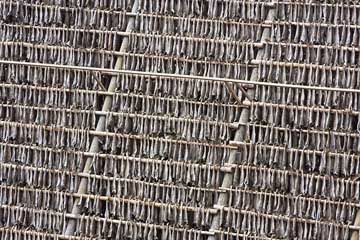 |
|
Racks of cod, known as stockfish, dry in Honningsvag, Norway. This dried fish was the basis of Norwegian economy for centuries and is still an important export. The cod are caught from January to April and then set out on racks to dry. Once dried, the fish is rock hard and can last without refrigeration or other preservation for 10 years. It is usually soaked for several days, then cooked or pounded in its dry state and eaten like jerky. |
|
| |
|
|
|
|
| |
The guide stands with an ax in his hands. He takes a swing at a log on the chopping block. Only, it's not a log. It's dried fish, the basis of Norway's food chain.
Yeah, the stuff is hard as wood.
"A good assault weapon," one local quips.
Slivers are handed around. Fish jerky. Not bad.
It's not the first surprise for me here. |
|
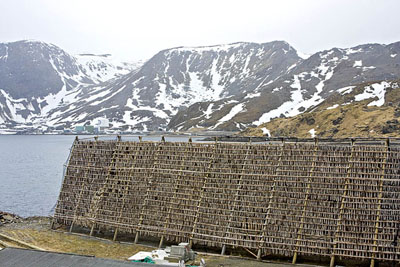 |
|
| |
|
|
|
|
| |
Hurtigruten's cruise ship voyage up Norway's coast is not so much a boat trip as it is a chance to see another culture ... to travel with the locals, to meet the people of the land. And, oh yes, to nibble their food.
It doesn't hurt that you are in the same "hotel" for seven days, spared the hassle of incessant packing and unpacking while the world passes by your nose.
We started in Bergen, with its rich history of the Hansiatic League (a Middle Ages German trade guild that controlled everything), its wonderful museums, its narrow alleys with centuries old wood buildings, its even more wonderful fish market full of smoked salmon and cod but better yet, of cheap caviar. |
|
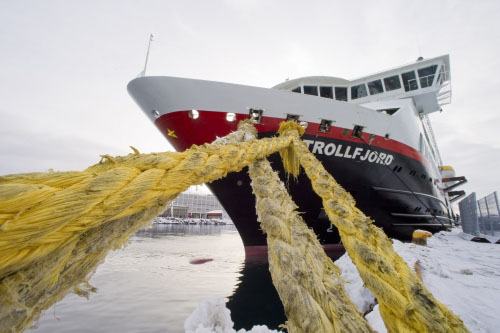 |
|
| |
|
|
HM Trollfjord Hurtigruten cruise line (c) Klaus-Peter Kappest, Germany |
|
| |
Waterfront in Bergen, Norway known as the Bryggen district. Old wood buildings date back to the 1700s and today hold craft, tourist and clothing shops. Bergen was the trading center of the Hanseatic League and northern Europe in the Middle Ages. Today it is the southern terminus of Norway's shipping lines. Though Bergen sits at 60 degrees north latitude, the Gulf Stream gives it the climate of a place 15 degrees further south such as Portland, Oregon. Bergen has more wooden buildings than any other city in northern Europe. |
|
Fløibanen funicular car makes its way up the mountain with the waterfront and harbor of Bergen, Norway, in view. The center of town is surrounded by seven mountains and this one, Fløien, is the best known of the mountains. |
|
| |
|
|
|
|
| |
And then we were in Alesund, our introduction to Geiranger Fjord. National Geographic Traveler calls the Norwegian fjords one of the world's most untouched destinations and Geiranger Fjord is on the UNESCO World Heritage list.
Okay, so you get the idea this is pretty spectacular.
The highlight was a shore excursion along the fjord that started with a bus ride up Eagle's Road, 11 seriously sharp switch back turns that climb 2,135 feet. Off in the distance, we could see the occasional farmhouse, sitting above terrain so steep it could only be reached via ladders. |
|
| |
|
|
|
|
|
| |
Back aboard, the next few days were a succession of charming towns and villages, each with its own special features:
Alesund features Art Nouveau architecture ... a flowery style with curved lines, round towers and bas relief fruit etched across the buildings.
Trondheim has Nidaros Cathedral, breathtakingly intricate stonework built in the 12th Century. But also, it has an open air museum with buildings from its past and a stave church where, in summer, your guide will sing medieval hymns.
Tromso, Paris of the North, has the stunning Arctic Cathedral, whose stone triangle rises 120 feet like a mountain of ice. Inside is a mosaic of 11 tons of colored bits of inlaid glass. And Tromso also has Polaria Aquarium, where you can walk through a glass tunnel while seals swim over your head. |
|
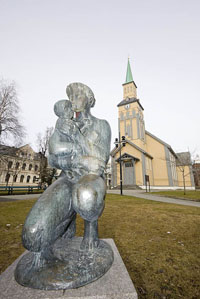 |
Bronze sculpture in front of The Cathedral in Tromsø, Norway. This is one of the largest Protestant wooden churches in Europe. |
|
| |
|
|
|
|
|
| |
|
|
In the end, though, the trip is about the people and the ship.
"Hurtigruten" means "fast route" and from the beginning this ship line has been a combination cargo/mail carrier, ferry and tourist adventure. Before Hurtigruten, it could take mail months to traverse Norway. The shipline reduced this to days by finding a new... a fast ... route up the coast.
In 1893, its first year, the ships carried 6,000 passengers along the coast. Today, the average is 460,000 a year on 12 ships.
But unlike the Alaska marine ferry, which can be rustic and feature people camping in tents on deck, Hurtigruten's top ships, the Millennium class, are true cruise ships with efficient, if somewhat small, standard cabins, top notch food, even nightly entertainment and hot tubs.
These ships are not, however, aimed at Americans, which means no midnight buffets, a lot of unexpected extra charges (mid afternoon coffee for instance) and very little hand holding. You are expected, frankly, to do a lot of wandering on yoru own. |
|
| |
Norway, Hurtigruten, Bergen, MS Trollfjord (c) Klaus-Peter Kappest, Germany |
|
Our trip on the MS Trollfjord went north from Bergen to Kirkenes, stopping at 34 towns, passing the Arctic Circle, the northernmost point of the European continent, and a host of spectacular inlets. |
|
| |
|
|
| |
None was more thrilling, though, than Trollfjord.
At 11pm to the strains of Greig's "Hall of the Mountain King," we entered the cut. It's only 1.2 miles long but every inch is breathtaking. At its tightest, the fjord is 120 feet across. The ship is 80 feet, meaning a vessel large enough to carry 822 passengers had only 20 feet of clearance on either side.
And what stood before us were twin sheets of rock 3,000 feet tall, sliced with waterfalls. At the end, the captain nosed the ship to within mere feet of the rock, then using small bow propellers, just slid it around like a dancer twirling in slow motion. |
|
| |
|
|
| |
|
|
| |
Passengers at bow of MS Trollfjord wave to people who line the tall bridge spanning the narrow sound of Stokksund along the coast of Norway. |
|
| |
|
|
| |
Of course, we also had an Arctic Circle ceremony for crossing 66.33 north.
First King Neptune, beard, cape, trident and all, greeted us in three languages. Then candidates knelt while Neptune dribbled ice cubes down their necks. Our reward was a shot of crowberry wine. |
|
| |
|
|
| |
And other times we explored the ... food. |
|
You don't think of Norway as being a place for adventure food but if you embrace the |
|
| |
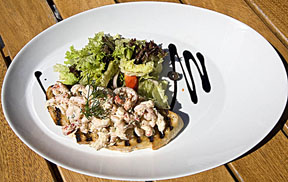 |
|
local cuisine, you an not only have fun but learn the culture.
Fish is what keeps the country afloat, so to speak. Locals were writing poetry to their quirky dried fish 500 years ago.
Clipfish is made from dried, salted cod and is, well, salty. Stockfish, which is only slightly salted and exported to most of Europe, is considered a national treasure. Only the Norwegians seem to have the right wind and temperature to air dry cod. Racks line the bare hills in the far north and it is prepared in any number of ways ... eaten with a bit of butter straight like jerky, soaked and boiled, fried, you name it. |
|
| |
Typical open faced Norwegian sandwich featuring shrimp salad and greens. |
|
|
|
| |
|
|
| |
What made it so valuable was that it could last unrefrigerated for 10 years. It dries rock hard and in its natural state, can be, one local quipped with an absolutely straight face, used as a lethal weapon. There's a museum up north where the guide takes an ax to the stuff.
Then, there is gjetost, Norwegian brown cheese. It's the color of peanut butter, has a distinctive gamy taste and comes in various strengths ... goaty, goatier, goatiest.
It also quickly becomes an addiction.
We also sampled lots of reindeer, which is lean and tasty. And at a Sami camp, we had reindeer broth, which was heavy with the taste of marrow and perfect in cold, wet, snowy weather. |
|
| |
|
|
|
|
| |
There were other adventures beyond the food. In Bodo we went on a rib boat ride ... a rubber Zodiac boat where we sat wedged in like a roller coaster car. Call it an amusement ride with benefits. We saw eagles, eider ducks and thousands of seagulls. But best of all, we played alongside the infamous Maelstrom, the 30 foot wide whirlpool mentioned by Jules Verne in Journey to the Center of the Earth.
When we left Bergen in early May, it was spring. Flowers were blooming, the air was warm. After the Arctic Circle, it started, finally, looking like the far, far north. Soft green hills gave way to sharp snowy peaks. Snow lay on the ground in patches down to sea level. Ice filled shallow lakes and a couple of times, it actually snowed.
|
|
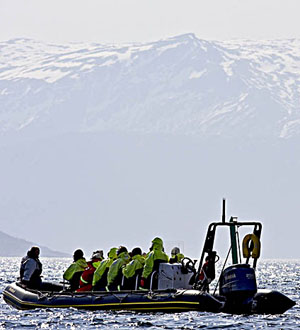 |
|
| |
|
|
Tourists ride in a small rubber boat to see birds near the town of Bodø along the coast of Norway. |
|
| |
|
|
|
|
|
| |
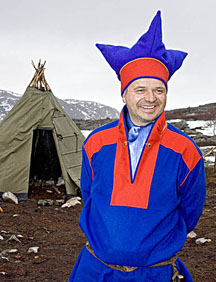 |
Middle aged Sámi man in traditional clothing stands by his tent and talks about the life of his people at his camp near the Norwegian town of Kjøllefjord. The Sámi, also knowns as Laplanders, are a nomadic native people who live in the arctic regions of Norway, Sweden, Finland and Russia and herd reindeer, following the migration patterns while living in tents. When not migrating with the reindeer, they live in simple cabins near arctic villages and towns and in Norway, have their own parliament. The Sámi people are among the largest indigenous ethnic groups in Europe. |
|
One of our last days, Antelias, a young Sami man came aboard and told us about native Sami life ... that half of all Sami (Laplanders) live in Norway, that some people still do live in tents when migrating but most today live in simple cabins, that they don't herd the reindeer so much as follow them.
But when I asked how many reindeer his family owns, Antelias frowned slightly. "That is a disrespect," he said.
Later, I learned that originally such figures were secret because of tax matters but today, it's just considered rude ... as if you walked up to a stranger, in say, Los Angeles, and asked him how much money he makes. |
|
| |
|
|
|
|
|
| |
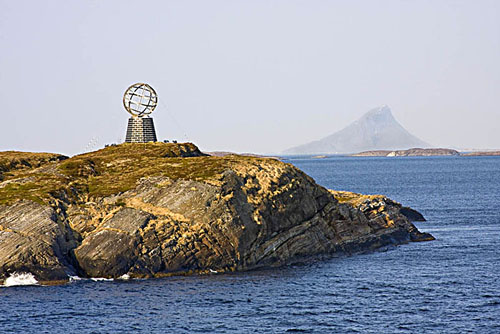 |
|
| |
Arctic Circle marker on rocky coast of Norway. The Arctic Circle, at 66 degrees, 33 minutes north latitude marks the southernmost point at which the midnight sun shines 24 hours a day on the longest day of the year. The globe sits on the small island of Vikingen. |
|
| |
|
|
| |
Antelias also sang a traditional Sami song for us. It was more a chant really, and sounds almost Navajo. Their tents, by the way, are teepees. This similarity can't be coincidence.
We were really settling into a routine, watching people come and go, watching cars, furniture, pallets of food and beer, barrels of who knows what come and go.
Our last full day, at the top of Norway, it truly looked like the far north. The low hills were striped with snow. Fog hung over the landscape, sifting like smoke through the round peaks. Trees were far to the south and the tallest thing that grew was brown, grassy scrub.
Yet, tucked in a cove was a collections of houses painted in Norway's ubiquitous red, yellow and white ... the fishing village of Havoysund, clinging to existence here at 70.59 North. |
|
| |
|
|
| |
|
|
 |
|
| |
Vigeland Sculpture Park in Frogner Park, Oslo, Norway. The 80 acre park contains 212 granite and bronze sculptures all modeled in full size by Gustav Vigeland over a period of 40 years. Vigeland also designed the architectural setting and the layout of the grounds. |
|
People walk by cherry blossoms in bloom on tree on a street in Bergen, Norway.
|
|
| |
|
|
| |
And then, after seven days, we were in Kirkenes. The ship turns here and heads back south. Many people stay aboard, doing the round trip in 11 days. Kirkenes, it turns out, is somewhat of an adventure capital. In summer, you can go out with a crab fisherman, watch divers bring up crabs and have them cooked for you, fresh. In winter, the trip is by snowmobile and the fishing is through the ice.
Oh heck, I'm gonna have to come back. |
|
| |
|
|
| |
NORWAY'S SURPRISING SECRETS |
|
| |
|
|
| |
1. Norway's strawberries and carrots are famous throughout Europe for being super sweet. It is a combination of cold to shock the plants into producing extra sugar and lots of sunlight in summer. Also, apples, pears, plums and cherries are grown on postage stamp plots carved out of the steep hillsides of the fjords.
2. Winter is a great time to visit. The weather is actually drier then, the skies are clear, the northern lights are fantastic and along the coast, the temperatures are mild. Even at its darkest, there is light ... a dreamy blue that is starlight and moonlight reflected off the snow.
3. Norwegians eat more pizza per capita than any other people on Earth. The tiny town of Stordal, population 1,000, makes and exports frozen pizza and as a result, the unemployment rate is zero.
4. Virtually all Norwegians speak English. They study it from Grade 4 on.
5. The Sami people are not Norwegians. They are related to Finns, Hungarians ... and Koreans ... with round faces, high cheekbones, dark hair and slightly slanted eyes. They have their own non Viking history going back thousands of years and today also have their own parliament.
6. Vikings never wore hats with horns. Credit this myth to Wagner's Valkyrie opera. Nor did they "bury" their dead by sending burning ships to sea. We've got a Kirk Douglas movie to thank for that.
7. The Polar Circle marker is actually either 300 yards or 1.2 miles south of the real circle but it remains where it is because this spot is more photogenic. The North Cape, at 71.10.21 North (a mere 1.255 miles from the North Pole, by the way), isn't Europe's northernmost point. The real north point is another mile further on but can only be reached by hiking a 5.5 mile trail. But, hey, the North Cape has Europe's northernmost gift shop, post office ... and flush toilet. |
|
| |
|
|
| |
CONTACTS |
|
| |
|
|
| |
Hurtigruten ships travel the coast of Norway year round. The most upscale are the three Millenium class ships, MS Trollfjord, MS Midnatsol and MS Finnmarken. Standard cabins are small but exremely well laid out. The ships make an average three dozen stops, some for just 20 minutes but many for several hours so passengers can wander and take guided tours. Price for standard cabin one way averages from $1,000 to $5,000 US, depending on the time of year, the ship and the cabin.
For everything Norway: www.visitnorway.com/us
For Hurtigruten Cruises: www.hurtigruten.us
For the Sami people: www.norway.org/facts/sami/sami/htm
And in Oslo
For Oslo: www.visitoslo.com
For Vigeland Sculpture Park: www.Norwayguide.no/ta/vigeland.htm (Two hundred naked granite and bronze statues carved by Gustave Vigeland, the one thing in Oslo you shouldn't miss)
Other sites you should visit: Viking Ship Museum, Maritime Museum, The Oslo opera house, Nobel Peace Center. |
|
   
|

